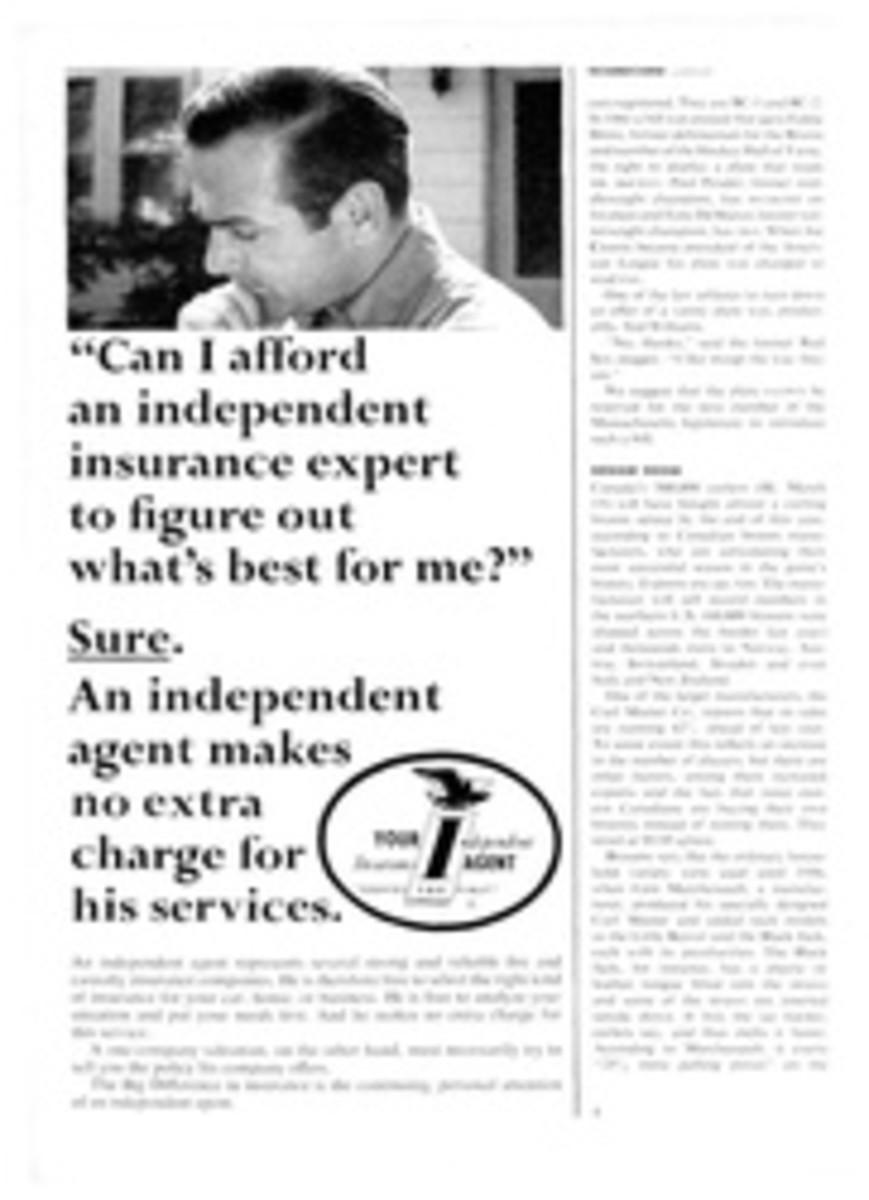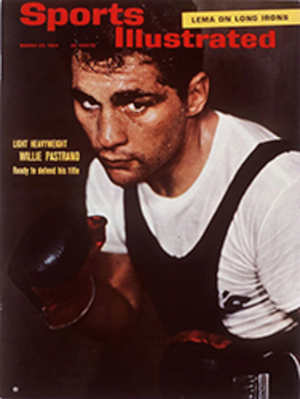
Another Morgan sails the sea for treasure
Nobody (officially, anyway) has yet asked Charlie Morgan to build a boat to defend the America's Cup in 1967. But the most excitable yacht designer in the business is pretty positive that before long somebody will—so he is getting his ideas for a new defender down on paper, and is even putting some of them in a testing tank. "I'm taking off in a whole new direction," Morgan said in a rare moment of quiet during a race last week, but before the new direction could be clearly defined, Charlie Morgan was off on still another tack. He was intent on beating a fleet of ocean racers to Nassau as skipper of a brand-new boat of his own design, the 60-foot yawl Maredea, and winning a race is no casual matter for Charlie Morgan.
At the helm of a boat, particularly one of his own design, this young (35) sailor-designer with the piratical name is like a high-tension wire that has been doused with salt spray. He splutters, he fumes, he rants and he shouts in a single-minded, frenetic determination to get the boat to the finish line first. As Maredea headed out from Miami in the final distance race of the Southern Ocean Racing Conference, the wind was fair for a reach across the Gulf Stream, and Morgan had piled on all the sail his boat could bear. "What do you think this is, a midnight race?" he yelled at his panting crewmen (it seemed to me we already were working our hearts out). "Lookit those boys on Figaro [a smaller boat that should have been dropping back faster], they're 12-meter sailors. You don't see them sitting around."
A puff funneled through the Miami Beach skyline. Maredea staggered for a moment under the press of sail until Morgan gave her her head. Then she took off with sudden new vigor. "Yippee," yelled the skipper, "Wowee." The puff left and two crewmen abandoned the weather rail where they had perched at Morgan's orders to balance the boat. For a second Morgan took his eye off the water, the sails, the wheel, the compass to reprimand them. "Get your tails back up there. Come on, don't just flop around, get up there and sit tail to tail. Get good and cozy."
For Maredea and her designer this was an important race. When Space Scientist Dr. Homer Denius of Melbourne, Fla., a man who likes to be No. I, asked Morgan to build him a new boat, he specifically asked for a craft that would be 1) the most comfortable cruising boat possible, and 2) the fastest Class-A ocean racer in the world. With her 14-foot beam, 40-foot waterline and 1,550 square feet of working sail, Maredea—the biggest fiber-glass boat of her kind ever built—fulfilled the first requirement easily. She has one more cabin than any other boat her size, 2¾ tons of air conditioning, hot and cold running showers, complete cabin ventilation system and a deep freeze that, even open, keeps butter so hard one has to cut it with a hacksaw. The second part of Denius' request was more difficult.
Maredea's owner had hoped to accumulate victories through the S.O.R.C, then go north for the New York Yacht Club Cruise, the Bermuda race, and perhaps the Transatlantic. His new boat won her first race handily but, after the next two—the Fort Lauderdale and the Lipton Cup—hopes began to sag. With the wind fair for Nassau, it was an open question whether the yawl's big, taut spinnakers or her equally taut skipper were pulling harder to win.
"Who's on the main?" Morgan suddenly demanded as Maredea leaped ahead. "Suck that momma in, Big Daddy," he yelled at the sweating hand. Then, "Let it out, damn it," as a puff struck. The puff passed and the crewman let the sheet run. "No," screamed Morgan, "you're too late." The crewman, now thoroughly out of step, pulled it back in. Morgan, speechless, snatched the mainsheet with his left hand, controlling the bucking wheel with his right. With feet braced against the yawl's motion, one hand on the sheet, the other on the wheel, he was like a sinner in a pillory. In time, someone relieved him at the wheel and Morgan devoted himself to the mainsail, trimming and easing the sheet with every change of wind speed. Suddenly he spotted something wrong with a spinnaker. He surrendered the mainsheet and darted over to concentrate on this new chore. With all sails drawing properly at last, he charged up to the bow and for a moment just stood there. "You know," he said to no one in particular, "I'm a far better crew than I am a skipper."
Through all the afternoon and into the moonlit night the Nassau-bound fleet moved onward. Occasionally innocent little puffballs of cloud skimmed between the moon and boats. Beneath the clouds hung stinging cones of wind. These miniature squalls sent Maredea surfing down in an explosion of foam and flying fish. Often the helmsman could not stop her from swinging into a rhythmical roll. Meanwhile, the main boom strained against the line (known technically as a vang) that kept it from rising beyond a horizontal position. Most skippers would not dare rig such a line in a heavy sea for fear the boom might bury itself in the water during a roll and be unable to float free. But Charlie Morgan is not most skippers. As Maredea plunged forward, he was merrily whistling the air of Blow the Man Down. Then he remembered the sailor's superstition about whistling. "Better not do that," he muttered, and changed the whistle to a Spanish song until Maredea began to roll again.
But the hex apparently had taken hold. As the watch was about to change at midnight another pocket of wind raced over Maredea. The man who had relieved Morgan at the helm, his arms and shoulders weak from fighting the slippery wheel for half an hour, allowed Maredea to run across the sea. Down went the vang-lashed main boom, digging deep into the water, unable to rise. Unable, as well, to absorb the shock of the cataract of water rushing over it, the big spar snapped with a huge metallic thunk. Made of aluminum and thick as a young telephone pole, the boom had broken almost precisely at the vang. Morgan was outwardly philosophical about the accident. "I knew we should have taken the vang off," he said.
While crewmen attempted to repair the broken boom, Maredea drove on under spinnaker and mizzen spinnaker. Six hours later, as the squalls grew less frequent and the sun began to rise, the mainsail was raised again. But a good half an hour—or four miles—had gone with the main, and so had Maredea's chances of winning the Miami-Nassau. "This is the first boat of mine that's broken a major piece of gear," said Morgan, as Maredea slid up to the dock, a miserable fifth in Class A and 14th overall—far behind Joe Byars' amazing little 40-footer Doubloon, which repeated her Miami-Nassau win of two years ago. "I think," said Owner Denius, "that we won't race up north this summer after all. I think we'll just cruise to Trinidad instead."
Obviously Morgan's latest boat is not the instant giant beater she was expected to be, but neither is she a dog. With her bugs shaken out, she will doubtless record a respectable number of wins in the future—but the future is not yet, and Charlie Morgan is an impatient man. Nevertheless, he took the defeat in stride. "If you go ocean racing," he said, "you must be prepared for heartbreak."
After a few martinis and a meal of burnt conch, Morgan's heart had partially healed and he was ready to talk again about the future and the past. "The minute I was exposed to sailing," he said, "I wanted to design boats and sail them." Since there were no schools offering courses in naval architecture for a boy of 10, young Morgan had to content himself with building model sailboats and, at every opportunity, sailing in real ones. After school, on weekends and holidays, he worked for Tampa Sail-maker Clinton Johnson. At 17 he already had raced from St. Petersburg, his hometown, to Havana. Three years later, he sailed a little old-fashioned gaff cutter in the same race with his present business partner, Bruce Bidwell. They nearly beat a brand-new, hot ocean racer full of the latest gear and sails.
Morgan can't recall just which of them was his first, but thinks he has owned at least 22 boats of one kind or another, including Snipes, Thistles, Lightnings, and a Star. The boat that brought him his first real fame as a designer, however, was Paper Tiger, a startling innovation in fiber-glass construction that proved a topflight ocean racer (SI, June 18, 1962).
After Paper Tiger Morgan began to concentrate on designing bigger and better boats—like 12 meters. He also went to a hospital for a month after taking too many antibiotics. Confined to a bed, he managed to set up three drawing boards. On one were the lines of Sabre, which turned out to be the winner of last year's Fort Lauderdale race; on another was a 74-foot fiber-glass hull; and on the third was Morgan's dream of a 12 meter.
Morgan has what amounts to an obsession over the America's Cup, and his designing skill will certainly play a part in the next defense. "I feel it's a national thing—it's part of our heritage," says Morgan. "Us younger people have a duty to be prepared when the time comes," he says. Just what Morgan has in mind for the cup probably will not be disclosed until his boat is launched. But it is pretty sure to be something new and startling. Morgan had never sailed in a 12 or even seen one until 1962, when he served as a crewman aboard Olin Stephens' Columbia. "Up to that time," he says, "my ideas leaned in the direction Ted Hood was taking." Hood's Nefertiti was the beamiest of all the 12s. "Then," Morgan explains, "I sailed aboard Columbia and saw I was completely wrong."
Columbia's designer has long been a Morgan idol. Charlie carried the plans of Stephens' famed ocean racer, Stormy Weather, in his pocket until they disintegrated from being unfolded and refolded. While Stephens' influence surely will be felt in any design Morgan turns out, it is safe to say that he will add something of his own. Stephens himself will still be around the next time the cup is defended, and if Morgan wants to win, he'll have to beat the master—and Morgan is a man who likes to win. "They say," he says, "that I'm too serious about winning. But it's not that. It's just that I'm serious about not losing."
PHOTO
THE WORRIED, EXCITABLE SKIPPER OF 'MAREDEA' STARES FIERCELY AT HIS COMPASS DURING THE RACE FROM MIAMI TO NASSAU

